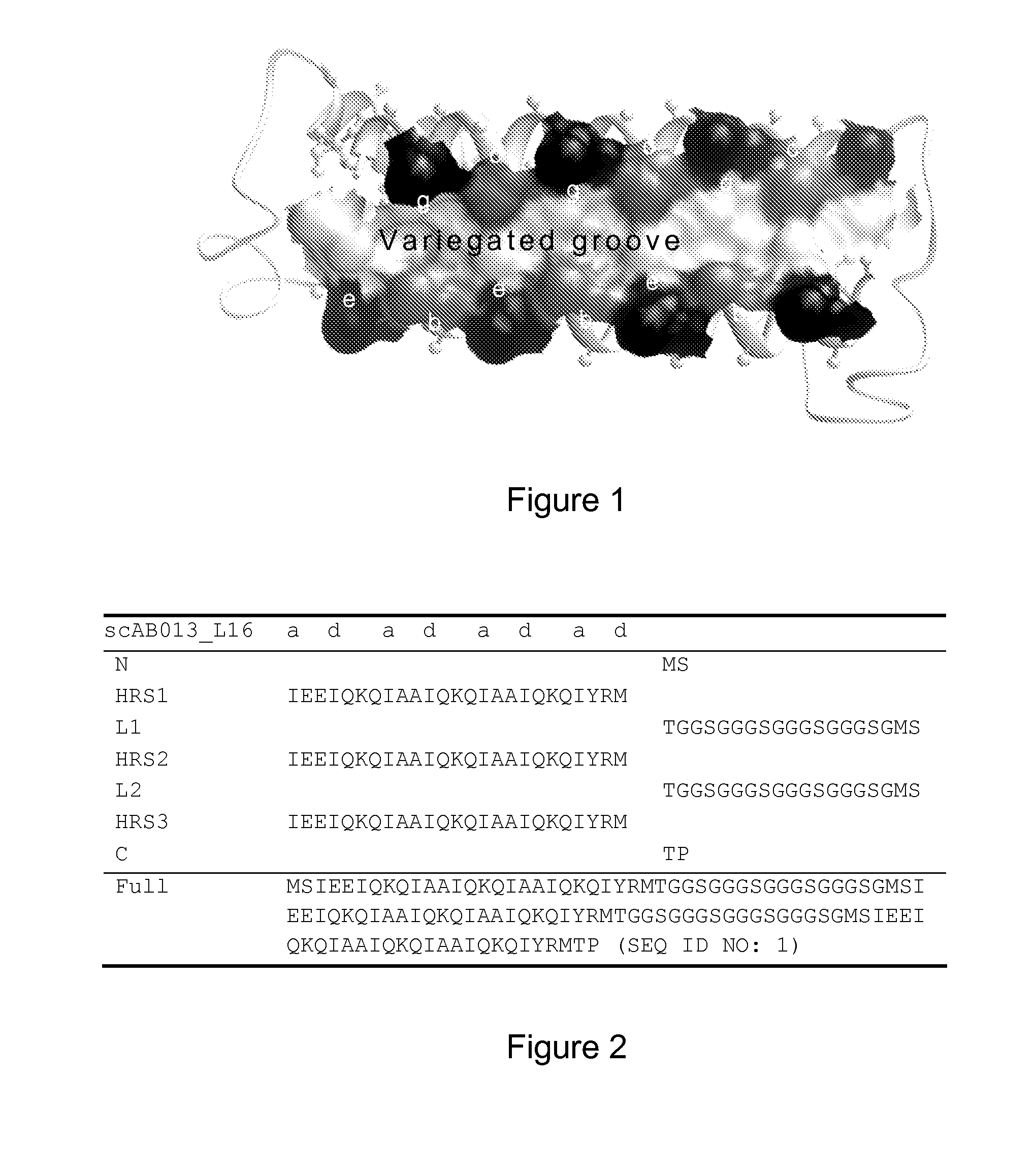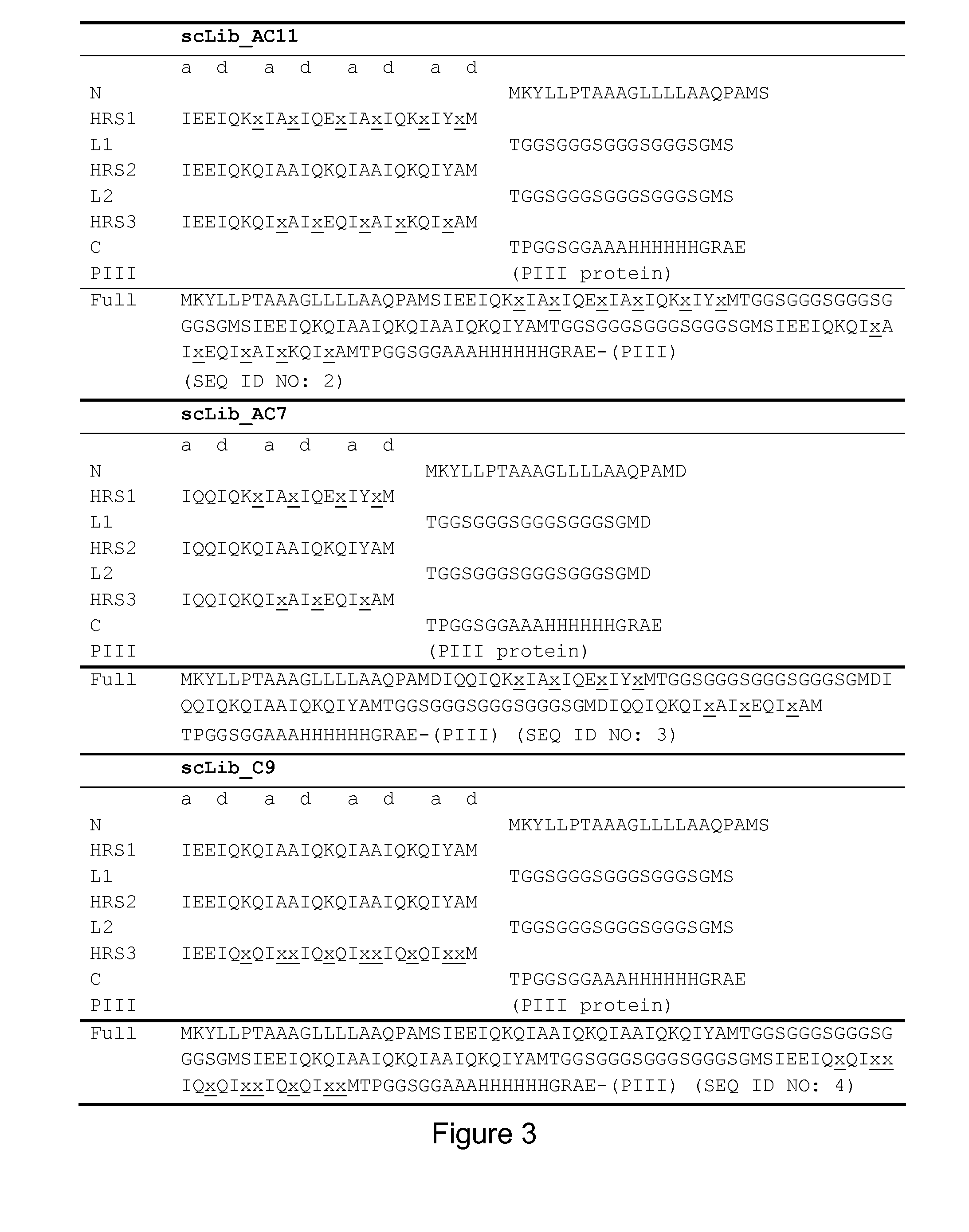Alphabodies specifically binding to viral proteins and methods for producing the same
a technology of specific binding and viral proteins, applied in the field of binding agents, can solve the problems of numerous side effects, nausea, vomiting, skin rashes, etc., and achieve the effects of high affinity and specificity, insensitive to radiation, and extremely (thermo)stabl
- Summary
- Abstract
- Description
- Claims
- Application Information
AI Technical Summary
Benefits of technology
Problems solved by technology
Method used
Image
Examples
example 1
Generation of Single-Chain Alphabody Library
[0267]The present example demonstrates that a single-chain Alphabody library can be obtained which is well-displayed on phage and which is potentially useful for obtaining single-chain Alphabody sequences that bind to a viral protein of interest.
[0268]A single-chain Alphabody random library was designed starting from the annotated amino acid sequence and a 3-D model of a reference Alphabody denoted ‘scAB013_L16’. A simplified 3-D model of this reference Alphabody is illustrated in FIG. 1. The amino acid sequence of scAB013_L16 is also provided herein as SEQ ID No: 1. The sequence is further shown in FIG. 2, wherein the conventional heptad core positions are indicated as well.
[0269]An Alphabody groove is formed by two spatially adjacent alpha-helices of a folded Alphabody protein (FIG. 1). Since there are three alpha-helices per Alphabody, there are in principle three candidate grooves which can be randomized. The said 3-D model was inspect...
example 2
Alphabodies Binding to HIV-1 Env
[0276]The present example demonstrates that single-chain Alphabodies of the invention can be obtained by a method of the invention, for example by using a mixture of Alphabody groove and helix libraries as provided in EXAMPLE 1.
[0277]The viral fusion protein of interest was chosen to be HIV-1 Env. HIV-1 Env complexes, also known as ‘envelope glycoprotein complexes’ or ‘gp120 / gp41 complexes’ or ‘spikes’, are a primary target for treatment of HIV infection. They are displayed at the surface of HIV virions and cells that are engineered so as to express Env spikes. HIV entry into a target cell and cell-cell fusion are primarily mediated by the action of these glycoprotein complexes subsequent to their engagement with specific receptors at the target cell. The ability to block viral entry or cellular fusion by impeding the function of Env complexes is generally thought to be of high value for the treatment of HIV infection. The reference sequence for HIV-1...
example 3
Analysis of Further HIV-1 Env-Binding Alphabodies
[0283]In addition to the scAB_Env03 Alphabody of EXAMPLE 2, three other single-chain Alphabodies, obtained from the same biopanning procedure, were further characterized. The present example demonstrates that multiple Alphabodies can be obtained, that their amino acid sequences can be determined, that they are highly thermostable, that they have a high affinity for HIV-1 Env, that their kinetics can be determined, and that some of them may be antivirally active.
[0284]The three additional Alphabodies that were tested are referred to as ‘scAB_Env02’, ‘scAB_Env04’ and ‘scAB_Env05’. Their amino acid sequences are shown in FIG. 7. Some apparently preferred amino acid residues were observed at different variegated positions, although not any position was occupied by a single, unique residue type. For example, three distinct Alphabodies had a proline at the first randomized position in the A-helix (i.e., at position g in the first heptad). T...
PUM
| Property | Measurement | Unit |
|---|---|---|
| melting temperature | aaaaa | aaaaa |
| KA | aaaaa | aaaaa |
| dissociation constant | aaaaa | aaaaa |
Abstract
Description
Claims
Application Information
 Login to View More
Login to View More - R&D
- Intellectual Property
- Life Sciences
- Materials
- Tech Scout
- Unparalleled Data Quality
- Higher Quality Content
- 60% Fewer Hallucinations
Browse by: Latest US Patents, China's latest patents, Technical Efficacy Thesaurus, Application Domain, Technology Topic, Popular Technical Reports.
© 2025 PatSnap. All rights reserved.Legal|Privacy policy|Modern Slavery Act Transparency Statement|Sitemap|About US| Contact US: help@patsnap.com



